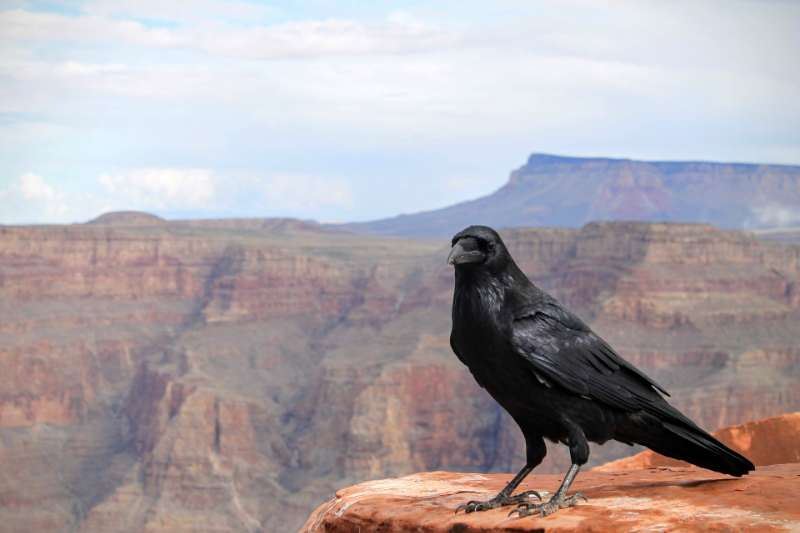Over 90 species of mammals call Grand Canyon National Park home, giving this park higher mammalian species diversity than Yellowstone. From the largest land animal in North America to some of the highest bat species diversity in the United States, Grand Canyon is home to a far larger mammalian population than many people think. Most visitors to the park see mule deer, elk, and squirrels, but many of Grand Canyon's mammals are secretive or nocturnal and move around unnoticed.
Bats

Grand Canyon National Park is home to one of the highest bat diversities anywhere in the United States, providing habitat to 22 species of bats. Many bats in the park eat insects, with the Little Brown Bat (Myotis lucifugus) capable of eating 1,200 mosquito-sized insects an hour. Others feed on fish and yet others eat the nectar of fruit-producing plants-helping to pollinate the plants.
However, a fatal disease has started to infect these creatures across the country. White-Nose Syndrome has not reached Arizona but is likely in the next few years. Although it’s unlikely you’ll encounter all of Grand Canyon’s bat species during your visit, look into the evening and night skies to view the only mammals capable of true flight.
Bighorn Sheep

One of the largest and most charismatic of Grand Canyon National Park's wildlife is the desert bighorn sheep.
This species is the largest native animal in the park with males weighing up to 300 lbs (135 kg), though two nonnative species living in the park, bison and elk are larger.
Though bighorn is generally associated with mountainous terrain, the unique landscape found in the Grand Canyon provides excellent habitat unlike any other on earth. The canyons have provided remote refuges for these animals and this is the only non-reintroduced population of desert bighorn.
Bison

American bison are the largest land-dwelling mammal in North America, weighing over 2000 lbs (900kg). Currently, bison are only found on the North Rim of the Grand Canyon.
Elk

Elk (Cevus elaphus) are the largest member of the deer family (Cervidae) in Grand Canyon National Park.
The Rocky Mountain Elk (Cervus elaphus nelsoni) in the park come from 303 individuals introduced to the state from 1913-1928 from Yellowstone National Park.
While they can appear calm, elk are wild animals that can be dangerous. Please view these animals from at least 100 feet.
Mule Deer

Mule deer (Odocoileus hemionus) are very common throughout western North America and are one of the most commonly seen animals in Grand Canyon National Park.
Their large ears resemble those of mules - hence the name.
They have a narrow tails which distinguishes them from white-tailed deer (Which are common in the United States but not found in Grand Canyon National Park).
Hog-nosed Skunk

The Grand Canyon is home to one of the world’s largest species of skunk, the American hog-nosed skunk (Conepatus leuconotus).
The park is north of the species’ known range, but two skunks were reported on river trips on the Colorado River in 2014. It is unknown whether the species has been overlooked in the Grand Canyon in the past, or if it has expanded its range northwest.
These sightings suggest a breeding population on both sides of the river. Park biologists are beginning a study of the distribution and presence of hog-nosed skunks in the canyon.
Mountain Lion

Mountain lions (Puma concolor) are the largest predators found in the Grand Canyon.
There are 18 native South American, 25 native North American, and 40 English names for this species, and the most common are puma, cougar, panther, and catamount.
Humans in Grand Canyon have no reason to fear mountain lions because they do not see humans as prey. For mountain lions, being hit by cars is a common cause of death. Please use caution when driving, especially on East Rim Drive.
Ringtail

This small mammal, often called a ringtail cat, miner's cat, or bassarisk is Arizona's state mammal. It is a common, albeit rarely-seen member of the Grand Canyon's fauna. The musky smell they excrete deters would-be predators such as foxes, coyotes, and bobcats.
Javelina

Javelina is known by many names: collared peccary and musk hog are commonly used. Javelina young are sometimes called reds because of the color of their fur at that stage. No matter what you call them, javelinas are not pigs. They are, however, hoofed mammals that look quite like pigs. Ancestors of today’s javelinas made the journey, over the Bering land bridge, eventually to Central and South America.
Rock Squirrel

Bats, mountain lions, and other wild animals are all dangerous animals that Grand Canyon tourists may encounter. However, the most dangerous wild animal that dwells in the Grand Canyon region happens to be the rock squirrel.
Also, rodents and other wild animals in the Grand Canyon area can spread infectious diseases such as Hantavirus, rabies, and plague. In fact, all three of these diseases have been found in the region’s wildlife in recent years.
Squirrels have become the most dangerous animals at the Grand Canyon partly as a result of the many attacks that tourists have suffered while attempting to take selfies with the nut-eating rodents. Selfie-related squirrel attacks have become so common at the Grand Canyon that park rangers have begun warning tourists about the dangers associated with “squirrel selfies.”
Feeling like visiting the Grand Canyon?
We have experience in the touring and travel industry and look forward to serving you with all your touring adventures! We offer special group/corporate rates and custom tours!
So, what are you waiting for? Plan and Book Your Trip with Christianson Tours
Contact us for Unforgetable and Affordable Grand Canyon Tours from Las Vegas:
📞(70) 2456 9200
📠(70) 2434 7163 - (Fax)
📧[email protected]
🌐www.christiansontours.com



































